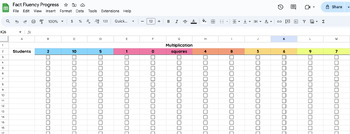Multiplication and Division Fact Fluency Progression Checklist
- Google Sheets™

Description
Use this progression to orally test students on their multiplication and division fact fluency in a developmentally appropriate order. They should aim to pass one set of facts each week. I like to test them orally and out of order and switch the order of the factors. For example, if a student is testing on their 3’s facts, it might sound something like this: “What is 3x2? 4x3? 9x3? 3x7? 3x1? 0x3? 3x3? 3x5? 8x3? 3x6?” Students need to respond to each fact in 5 seconds or less to be considered secure. If they do not pass, ask them to keep practicing for next time.
Order Explanation: 2s, 10s and 5s are first because they can already skip count by those numbers. 1s and 0s because they need to understand the rule behind those. Squares (1x1, 2x2, 3x3...10x10) because they can later use those as helper facts. 4s facts they can double to get 8s, 3s they can double to get 6s, and 9s and 7s are last because they are the hardest facts to find a rule for.


